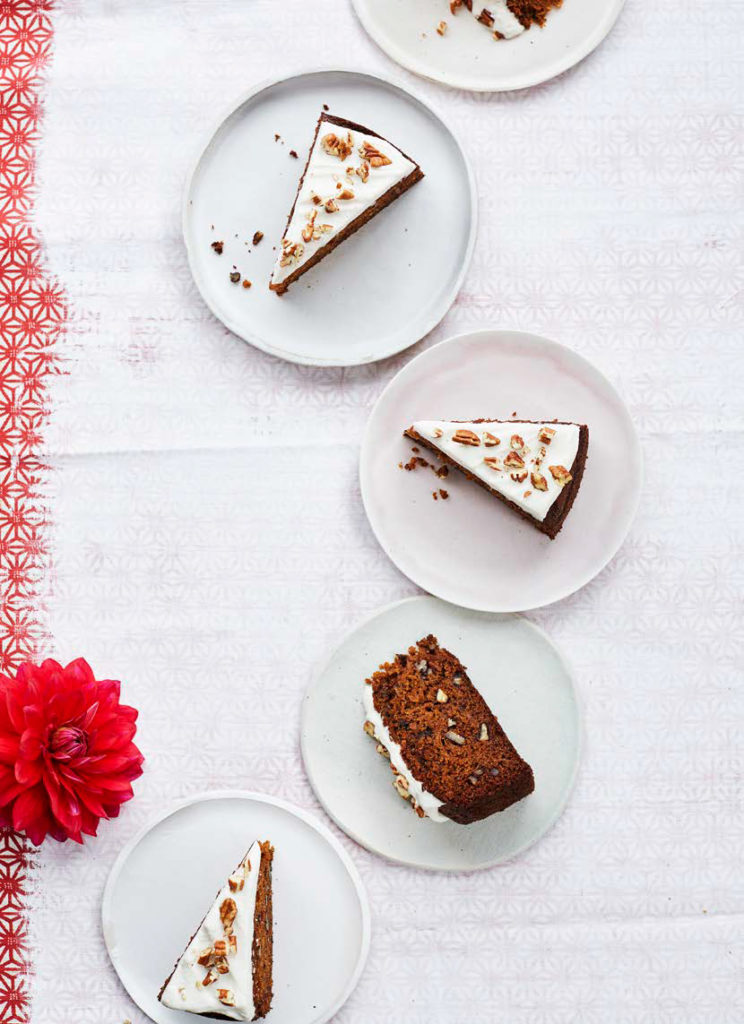Equipment 23cm round, deep, loose-bottom cake tin
Sorry for the melodramatic title of this cake but to be honest it was life-changing for me, so please just go with it. It’s the complex play of the spices that really brings this cake to life. Cloves, cardamom and cinnamon combine to heighten the flavours and aromas to an almost intoxicating level. With 500g of grated carrot in this cake there’s no getting away from its presence, though it’s surprising how the cake doesn’t really taste of it. Its purpose is to bind in the flour – in this case spelt, that is higher in protein and fibre than wheat. The fruity olive oil unifies all the other flavours. This recipe is so forgiving. Even overcooked, it’s still moist and delicious!
215 ml extra virgin olive oil
250g coconut sugar
4 eggs, beaten
250g spelt flour
2 tsp bicarbonate of soda
2 tsp baking powder
2 tsp ground cinnamon
1 tsp ground cloves
1 tsp ground cardamom
1 tsp salt
125g pecans, coarsely chopped
500g carrots, grated
Vanilla cashew nut icing or Maple cream
cheese icing (see below)
Roughly chopped walnuts, for topping
1 Preheat the oven to 190°C/fan 170°C/
Gas mark 5 and line a 23cm round, deep loose bottom
cake tin with baking parchment.
2 In a bowl mix together the olive oil, sugar and
eggs until well combined.
3 In a second bowl combine the flour and the
other dry ingredients and make a well in
the centre. Add the egg and oil mixture and
stir thoroughly until it is all blended. Finally,
add the pecans and carrots and mix again.
4 Pour the mixture into the cake tin and bake
for about 1 hour 20 minutes, until a skewer
inserted into the middle comes out clean.
5 Allow the cake to cool in the tin for
10–15 minutes, then turn it out onto a cooling
rack. Once it’s completely cool, top it with
either Vanilla cashew nut icing or Maple
cream cheese icing.
Nutrition Note:
The olive oil is rich in monounsaturated fats that are better for your heart than the saturated fats in butter.
Vanilla Cashew Nut Icing
Equipment High speed blender
GF, DF, V+
We have to get really creative when it comes to ‘icing’ our cakes as we don’t use icing sugar. This recipe is one of our go-to icing recipes, it’s really easy to make and absolutely delicious. The basic recipe is for a vanilla icing, but it can easily be adapted to different flavours – we particularly like to add matcha for a vibrant green colour!
150g unsalted cashew nuts, soaked for
At least 4 hours but preferably overnight
300g full-fat coconut milk
2 tbsp lemon juice
75g maple syrup
1 tsp vanilla extract
100g coconut oil, melted
Drain and rinse the soaked cashew nuts.
Put them in a blender with all the other
ingredients and blend until completely smooth
and creamy. Pour into a container and chill in
the fridge until firm. We usually leave the icing
in the fridge overnight, but around 4 hours
should do the trick.
Maple Cream Cheese Icing
GF
This is our take on classic cream cheese icing. It’s a lot less sweet and totally delicious.
2 tbsp maple syrup
225g organic full-fat cream cheese,
straight from the fridge
2 tbsp coconut oil, melted
1 Stir the maple syrup into the chilled cream
cheese until completely combined.
2 Add the melted coconut oil and mix very
quickly to prevent lumps from forming.
Modern Baker: A New Way To Bake by Melissa Sharp with Lindsay Stark (Ebury Press, RRP £26). Photography by Laura Edwards.

